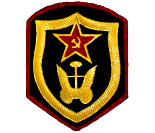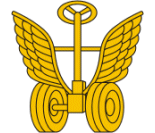Automotive Troops [Avtomobil'nye Voiska]
 Amateurs talk tactics, professional talk logistics. The American General Pershing said that "infantry wins battles, and logistics wins wars." After Russian armored columns entered Ukraine on 24 February 24, they quickly advanced more than a hundred kilometers from their rear bases. And then stalled. The 2022 Russian invasion of Ukraine was hampered by a lack of military trucks in the Russian army to provide food, fuel and weapons. Moscow's war machine is a monster that is as terrifying as it is difficult to feed. Logistical problems, misjudged capabilities of the Ukrainian military and serious miscalculations on the ground made Russia's invasion of Ukraine a painful and bloody task.
Amateurs talk tactics, professional talk logistics. The American General Pershing said that "infantry wins battles, and logistics wins wars." After Russian armored columns entered Ukraine on 24 February 24, they quickly advanced more than a hundred kilometers from their rear bases. And then stalled. The 2022 Russian invasion of Ukraine was hampered by a lack of military trucks in the Russian army to provide food, fuel and weapons. Moscow's war machine is a monster that is as terrifying as it is difficult to feed. Logistical problems, misjudged capabilities of the Ukrainian military and serious miscalculations on the ground made Russia's invasion of Ukraine a painful and bloody task.
The Russian army is traditionally weak in logistics and supply. Russia for many decades avoided placing large armies far from the borders. The US military, usually fighting abroad, developed its logistical capabilities and potential. While the Russian Federation allocated more of its own resources for tanks, combat aircraft and submarines. So, in each logistics brigade of the Russian army there are approximately 400 general-purpose trucks. Artillery, air defense and engineering formations will also need ammunition, fuel, food and spare parts.
Russia is huge and its roads are poor compared to those in Western countries. This helps explain why the country and its army rely so heavily on the railroad for logistics. A swift blitzkrieg and the capture of Kyiv failed, exposing the failures of the Russian army to the public. Instead of entering the Ukrainian capital in a matter of hours and appointing a puppet leader there, as the Kremlin planned, the Russian military suffered colossal losses. A large convoy of Russian military trucks and assault vehicles was stranded about 32 kilometers from Kyiv, according to intelligence released by the British Ministry of Defence. The column, several kilometers long, "was delayed due to the stubborn resistance of the Ukrainians , mechanical breakdowns and traffic jams," the report said. According to a British intelligence analysis, the convoy, which analysts say includes truckloads of food for soldiers, fuel for vehicles and heavy artillery, "has made no appreciable progress in more than three days." The Russians appeared to have poorly coordinated their sizeable and diverse capabilities and failed to organize the logistics for the invasion.
The Russian military may not want to drive heavy vehicles off-road "in the early spring in Ukraine" because the vehicle's tires weren't properly maintained. Military trucks need to be taken out once a month for preventive maintenance. Several photos and videos posted on the Internet showed damaged tires and abandoned equipment.
Lt. Col. Alex Vershinin noted: "Russia’s truck logistic support, which would be crucial in an invasion of Eastern Europe, is limited by the number of trucks and range of operations. It is possible to calculate how far trucks can operate using simple beer math. Assuming the existing road network can support 45 mph speeds, a single truck can make three trips a day at up to a 45-mile range: One hours to load, one hour to drive to the supported unit, one hours to unload, and another hour to return to base. Repeating this cycle three times equals 12 hours total. The rest of the day is dedicated to truck maintenance, meals, refueling, weapons cleaning, and sleeping. Increase the distance to 90 miles, and the truck can make two trips daily. At 180 miles, the same truck is down to one trip a day. These assumptions won’t work in rough terrain or where there is limited/damaged infrastructure. If an army has just enough trucks to sustain itself at a 45-mile distance, then at 90 miles, the throughput will be 33 percent lower. At 180 miles, it will be down by 66 percent. The further you push from supply dumps, the fewer supplies you can replace in a single day. The Russian army does not have enough trucks to meet its logistic requirement more than 90 miles beyond supply dumps. To reach a 180-mile range, the Russian army would have to double truck allocation to 400 trucks for each of the material-technical support brigades."
According to Article 13 of Federal Law of February 26, 1997 No. 31-FZ "On mobilization training and mobilization in the Russian Federation", "1. To provide the Armed Forces of the Russian Federation, other troops, military formations, bodies and special formations with vehicles during the period of mobilization and in wartime, a military transport obligation is established in the Russian Federation.
"2. The military transport obligation applies to federal executive authorities, executive authorities of the constituent entities of the Russian Federation, local governments, organizations, including ports, marinas, airports, oil depots, fuel transshipment bases, gas stations, repair organizations and other organizations that ensure the operation of vehicles, as well as for citizens - owners of vehicles.
"3. Compensation by the state for losses incurred by organizations and citizens in connection with the provision of vehicles and other property owned by them in order to ensure the defense of the country and the security of the state, is carried out in the manner determined by the Government of the Russian Federation.
"4. The procedure for fulfilling the military transport obligation is determined by the Regulations on the military transport obligation, approved by the President of the Russian Federation."
 The Land Forces consist of motor-rifle, tank, rocket and artillery units, air-defense units and army aviation. The special-purpose forces include engineer, gas and automobile troops, signals and logistical services and organizations. Automotive Troops [Avtomobil'nye Voiska] are special forces designed to resupply of ammunition, fuel, food and other supplies necessary for the conduct of hostilities, as well as to evacuate the wounded, sick, technology. They can transport troops, not having their vehicles. Consist of automobile (motor) units and parts, organizational constituent-Service and parts compounds, as well as parts and those of the armed forces or for separate automobile parts. Equipping the Army automotive technology and the emergence of the first automobile parts, teams and units demanded the creation of a special service, which was the training of personnel, maintenance and repair of equipment, supplies automotive parts, as well as provisions for their use.
The Land Forces consist of motor-rifle, tank, rocket and artillery units, air-defense units and army aviation. The special-purpose forces include engineer, gas and automobile troops, signals and logistical services and organizations. Automotive Troops [Avtomobil'nye Voiska] are special forces designed to resupply of ammunition, fuel, food and other supplies necessary for the conduct of hostilities, as well as to evacuate the wounded, sick, technology. They can transport troops, not having their vehicles. Consist of automobile (motor) units and parts, organizational constituent-Service and parts compounds, as well as parts and those of the armed forces or for separate automobile parts. Equipping the Army automotive technology and the emergence of the first automobile parts, teams and units demanded the creation of a special service, which was the training of personnel, maintenance and repair of equipment, supplies automotive parts, as well as provisions for their use.
Motor transport troops are Special Troops of Ground Forces which can transport troops which do not have their own motor transport. They consist of automobile (motor transport) elements which organizationally form part of combined units and compounds, and also parts and connections of the branches of services which comprise separate motor transport units. At present motor transport troops in their composition have automobile brigades, separate battalions. Road construction and maintainance troops consist of road-commandant and bridge brigades, separate road-commandant, road, and bridge battalions, and other parts, establishments and organizations. Training specialists for the road and motor transport troops is accomplished in the Military Logistics Academy in St. Petersburg), in the departments of military training of six civil VUZ (Institute of Higher Education) of the Russian Federation.
Today, this type of transport differs from ordinary trucks in the multi-purpose nature of use, and Russian military trucks also have increased reliability and ease of operation, which has been proven more than once in military operations with their participation. Modern trucks are adapted for transporting materiel and soldiers, towing artillery systems, installing weapons and directly participating in hostilities.
The war is not won only on the battlefield, and modern means of transportation, thanks to the good supply of the army and the rapid movement of the material base, make it possible to win battles even before they begin. The issues of the vehicle fleet in the Armed Forces of Russia are directly dealt with by the Main Armored Directorate. The management, in turn, closely cooperates with domestic automotive enterprises and design bureaus.
|
NEWSLETTER
|
| Join the GlobalSecurity.org mailing list |
|
|
|

